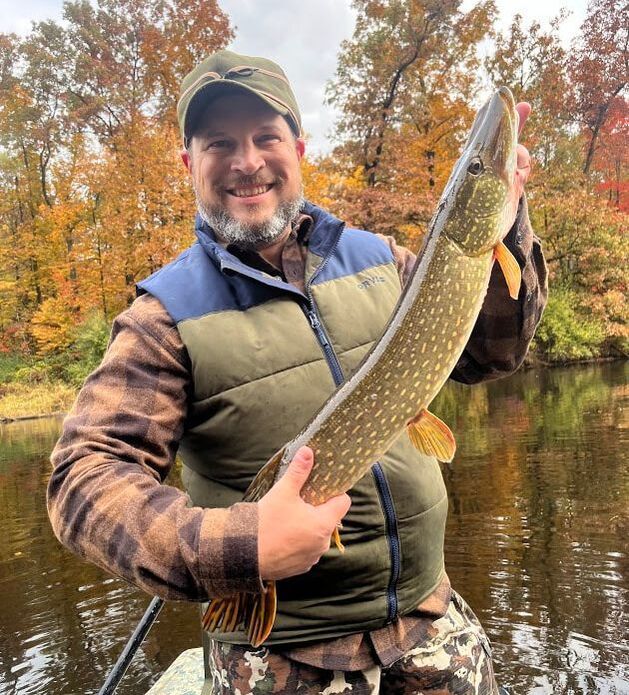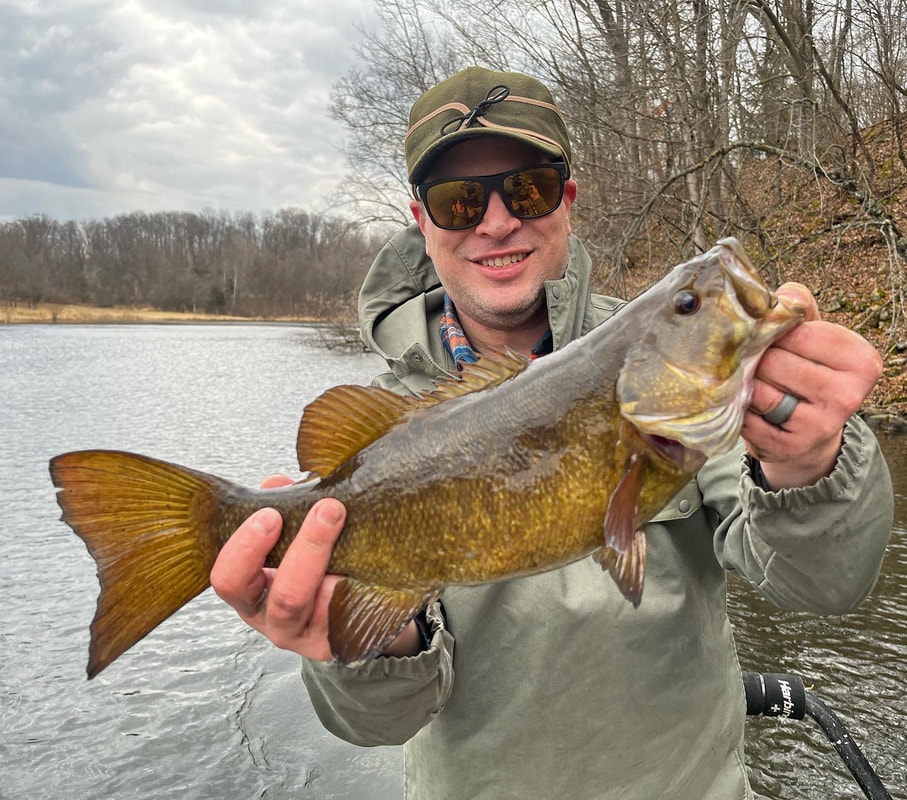|
This article originally appeared in the May 2022 issue of Woods-N-Water News.
By Drew YoungeDyke The guide suggested a different fly and handed me one of his to use, as I didn’t have a close match in my fly box. I cast into the pool near the fallen log, stripped it back, felt the tug like I snagged a log with some bounce, and landed the biggest smallmouth bass I’ve ever caught. That’s exactly how we all envision fly fishing with guides, right? If that’s your expectation, though, then you’re setting yourself up for disappointment; not because it’s not a possibility, it’s just not how it always works. When you fish with guides, what you’re paying for more than anything is their knowledge of the specific water, the advice of their experience fishing it, and their skill in maneuvering the drift boat to put you in likely places and good position to catch fish; however, the actual catching of fish is up to you, and neither one of you control the fish. In March, I had the opportunity to fly fish for smallmouth bass on a west Michigan river with two skillful Michigan fishing guides – Ted Kushion and Tom Werkman - as they scouted some water together. A trip like this accomplishes several things to help guides better serve their future clients. Aside from knowing where fish in that stretch of water like to hang out in certain conditions and at certain times of the year, fishing with other guides allows them to share tactics, strategies, knowledge, and experience with each other. And by having a full boat, we always had two lines in the water testing different flies, depths, and retrievals until we found what the fish liked. The forecast called for rain throughout the day with temperatures in the 40s, so we didn’t really know what to expect as far as actually catching fish. After a slow and fishless morning, our spirits were buoyed when Tom caught an accidental northern pike. They were out of season so he quickly released it, but at least fish were starting to eat! Soon after, Ted caught and released two nice smallmouth on black leech patterns with dumbbell eyes, using a faster retrieve than Tom or I had been. The bite was on! I was trying out some recent ties – a weighted white and brown Game Changer called the Sleeper Sculpin and a big olive Bucktail Game Changer that swam and kicked just right – but I hadn’t landed a fish. I narrowly missed a subsurface take on the Bucktail Game Changer as I saw a dark green head emerge right behind it, but in my excitement stripped the fly right out of its mouth instead of letting it pause for the take. However, I was pretty sure it was a northern pike instead of a smallmouth, so that was okay. While northern pike are my favorite species and I get excited about any northern pike fly fishing encounter, the season on them had closed for spawning so I only wanted to catch smallmouth that day. My Sleeper Sculpin was probably the wrong color, and the buoyant Bucktail Game Changer wasn’t getting down as far as Ted’s leech patterns, even with my sink tip-line. He handed me one of his flies – a black rabbit strip leech pattern with weighted dumbbell eyes and red rubber legs. I tied it on, asked the ancient Finnish water god Ahti for some luck, and soon hooked up with a fat, approximately 17-inch smallmouth! We didn’t measure it, but it was easily my biggest smallmouth to date. Ted rowed us to another spot on the river and Tom tied on a Low Water Cray pattern that caught five smallies in a row, including a beautiful golden-bronze tank with distinct dark stripes. I felt a tug on my line and stripped it toward the boat as a juvenile pike shook, rattled, and rolled. Ted netted it and I quickly released it. I cast again and again. A smallmouth followed but turned away from my fly. I cast again and felt that heavy tug, as a fat smallmouth fought its way into Ted’s net, about the same size as my first smallie. This one we measured precisely at 17 inches before releasing it. The bite window seemed to close as a storm rolled in. I tried rowing the drift boat and found increased admiration for the ability of Ted and Tom to maneuver with the skill they did. I typically fish solo out of a 15-foot canoe, or row and old 14-foot aluminum boat up at our Upper Peninsula cottage, but I’d never rowed a drift boat. None of it felt intuitive, and while I’m pretty adept at, for instance, mending my canoe float with a paddle in one hand and a fly rod in the other, I was pretty slow at rowing the drift boat, as the wind pushed me all over. It takes practice, coordination, experience, skill, strength, and endurance to row it for a full day float, and to maneuver and keep it in position for anglers to cast where fish might be. After a lightning strike, Ted wisely took over and rowed us to our takeout location. It was a great day of fishing – especially for March – as collectively we landed nine smallmouth bass and two accidental northern pike, and personally I caught my two largest smallmouth bass and a northern pike. It’s what you envision when fly fishing with guides, but it’s not always what happens and shouldn’t be expected. If we had only fished a half day, or kept trying the same flies, retrieves, and depths, we would have been skunked. We tried different patterns, different depths, and different retrieves until we found what worked – and the bite window turned on. Ted and Tom took water temperature readings throughout the day so they could better understand how that might have factored into the bite window. They noted that where we caught fish wasn’t necessarily in the exact places where they anticipated that we would catch fish. And they added all of that to their store of knowledge and experience as guides that they can draw upon to have better odds of putting paying clients on fish. Then they booked a trip the next week with James Hughes, head guide at Schultz Outfitters in Ypsilanti, to learn even more from him. When you fish with guides, there are some things that you should expect. You should expect that they have a logistical plan for the day, a safety plan, are proficient with their craft, and are knowledgeable about the water you’re on and the fish you’re pursuing. You should expect that whatever additional elements they advertised or you agreed to are met – like lunch or beverages. You should expect that they’ll do their best to put you in likely spots where fish might be and to share their knowledge with you to help you have the best chance to catch fish that day. However, they can’t control where the fish will be and they can’t catch the fish for you. Your ability to cast, to set the hook, to control the fish, and especially to listen to your guide are up to you. And don’t ask them to take you to their secret spot they don’t show to other clients; it doesn’t exist. They make their living by helping you have the best odds of catching fish that day, and if they know where fish are likely to be, that’s where they’re taking you, anyway. Finally, whether you get skunked or catch the best fish of your life, tip your guides based on the service they provided, not on the fish you did or didn’t catch. Fishing with guides is a great way to learn more about the water, the fish, the conditions, and improving your angling craft. They don’t have to be casting coaches, but just watching what they do and listening to their observations and advice improves your store of fly fishing knowledge. If you get the opportunity to fish with guides, entering the day with the proper expectations and mindset will yield a fishing experience that makes you a better angler, regardless of what you catch that day. And who knows? You might just catch the biggest smallmouth of your life, anyway. Contact Tom Werkman at WerkmanOutfitters.com and Ted Kushion at FlatRiverOutfitters.com. |
AUTHOR
Drew YoungeDyke is an award-winning freelance outdoor writer and a Director of Conservation Partnerships for the National Wildlife Federation, a board member of the Outdoor Writers Association of America, and a member of the Association of Great Lakes Outdoor Writers and the Michigan Outdoor Writers Association.
All posts at Michigan Outside are independent and do not necessarily reflect the views of NWF, Surfrider, OWAA, AGLOW, MOWA, the or any other entity. ARCHIVES
June 2022
SUBJECTS
All
|



 RSS Feed
RSS Feed